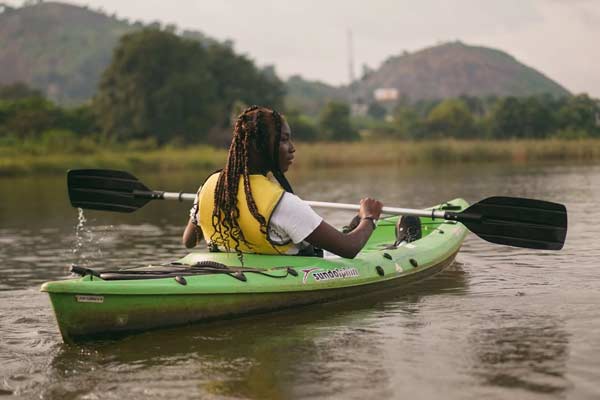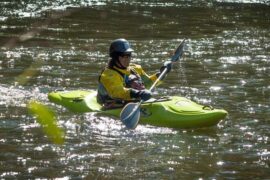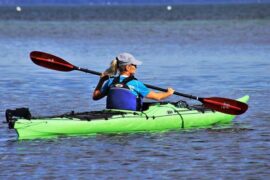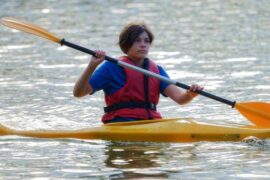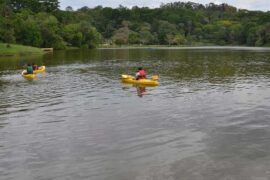If You Can’t Swim, Is Kayaking An Ill-advised Adventure?
Kayaking is a fun way to get some physical activity outside fresh air. Someone who cannot swim might not feel this same way, but in truth, kayaking is a suitable water activity for everyone.
You may wonder if it is safe to kayak if I can’t swim. Please take a few simple precautions, and yes, it is!
How Can I Kayak if I Can’t Swim?
Yes, Kayaking is a safe, fun sport. It is suitable for most people of all ages and abilities. Everyone can enjoy kayaking. If you are worried about knowing how to swim, then there are ways to make yourself safe on the water. The truth is, if you want to go kayaking, you can take precautions to make kayaking safe even if you can’t swim.
There are Still Risks
When engaging in any adventure that involves a body of water, there is always the risk of drowning. Even a well-experienced kayaker runs the risk. Circumstances are not always predictable, so to stay the safest, consider and address many possibilities before you get out there.
The risks can be minimized with some excellent pre-planning, a bit of knowledge, and adherence to some basic ideas and rules. As long as you have your wits, anyone who wants to should be comfortable getting out in a kayak.
Understanding Precautions
If you want to go kayaking, follow a few precautions. If you take the time to think everything through, then you shouldn’t have to be worried about taking an unwanted swim. Stay safe and, hopefully, dry with these ideas about kayaking when you can’t swim.
You NEED A Properly Fitting Personal Floatation Device (PFD)
A life jacket, or personal floatation device, is necessary for any kayaker, swimmer or not. This is the piece of equipment that is more than likely going to keep you safe if you don’t know how to swim.
This is the essential piece of equipment you have. And don’t skip it! Know the right way to wear one and what ratings mean, and you will be good to go.
Proper Fit
Most people need a vest that is class III or class V. These are buoyancy ratings meant to tell you how many pounds of floatation you need.
The idea is that 80% of your weight is water, and 15% is fat, so the remaining 5% is what the device needs to keep afloat. For a 200 lb person, the 15.5 or 22 lbs provided by either class is acceptable.
Wear Your Device Properly
When you put on the device, and all the zippers and buckles are fastened, there should be two straps on the side that will need to be tightened. You might need to have someone help you tighten these straps.
They should be tightened until the shoulder straps do not come above your ears when pulled on. Then your head will stay above water if you fall in.
Take a Guided Tour
At least the first time you go kayaking, and especially if you can’t swim, a tour is a great way to enjoy this activity and stay safe.
The professional leading the tour will teach you techniques to help you stay safe. This is also an intelligent choice, so you aren’t out there alone—another excellent safety precaution to use.
Location Matters
The tour is a great way to pick a spot that matches your skill level and keeps you safe. The company will tell you if they think the tour will be safe for a non-swimmer, as they are always focused on your safety.
Locations or tours on flat, calm lakes or in slow-moving rivers are the best choices as they minimize the risks of ending up in an unsafe spot in the water.
Tours Will Teach you Safety.
A professional leading a tour will usually inform you or at least explain, if not demonstrate, a couple of good techniques to understand in the water.
A wet exit will enable you to get out of a sit-inside kayak if you end up capsized, and the self-rescue will help you get back into the kayak from the water. Both are great to know and will keep you safe.
Make Sure You’re in the Best Kayak
Whether on tour or not, a good kayak choice will be an added safety measure on your trip. For beginners, a sit-on-top kayak is usually the best choice. They are far more stable than a sit-inside kayak.
Also, remember that the wider your kayak is, the more stable it will be as it distributes weight over more area. These factors will lessen the threat of capsizing.
Never Go Alone
For a veteran or a newbie, kayaking with a partner is the best choice. A partner can help check equipment and choose a location, and partners are there, so you’re not on your own in an emergency.
Never underestimate the value of being with a buddy. If you don’t know how to swim, a veteran kayaker might be best as your buddy, just in case.
Make a Kayaking Checklist
A list of all the essential things to remember is a great idea to minimize all the what-ifs. The list may look a bit like this:
- Buddy to go with
- Personal Floatation Device
- Drybag, for anything you need to take but don’t want to get wet
- Weather check
- Stable kayak
- Right location choice
A simple list may seem silly, but it ensures you control the most variables. This will minimize apprehension, and this is a must for a kayaker who can’t swim.
A Final Word
Kayaking is a great activity, whether or not you can swim. Make sure you’re prepared, and your trip should go as smoothly as your kayak will through the water.
